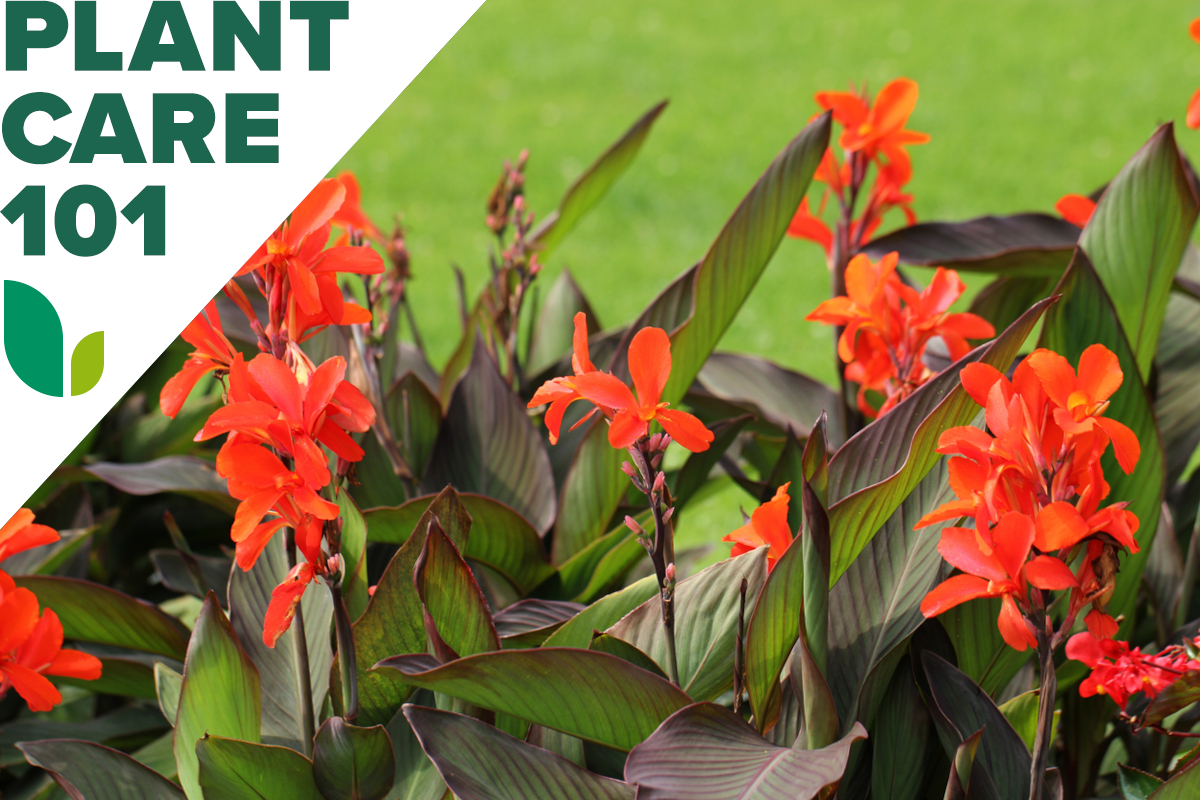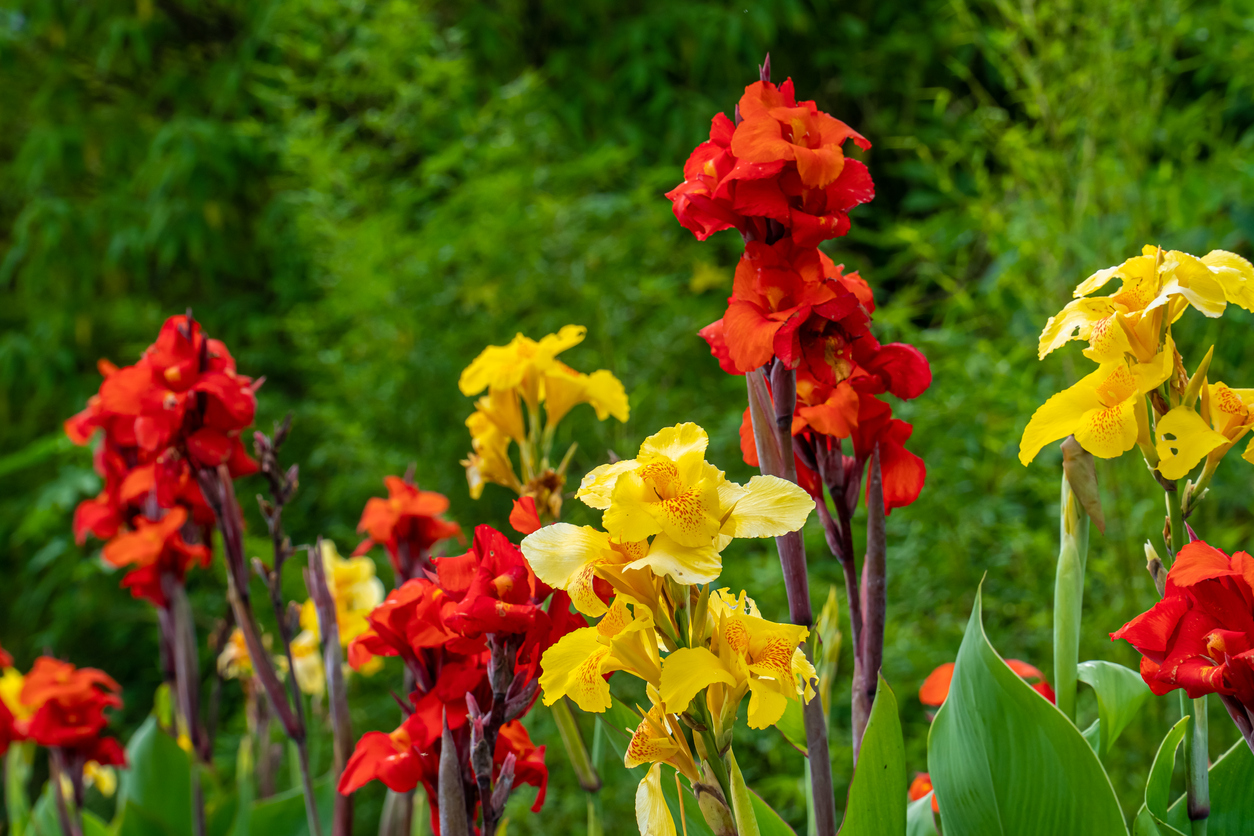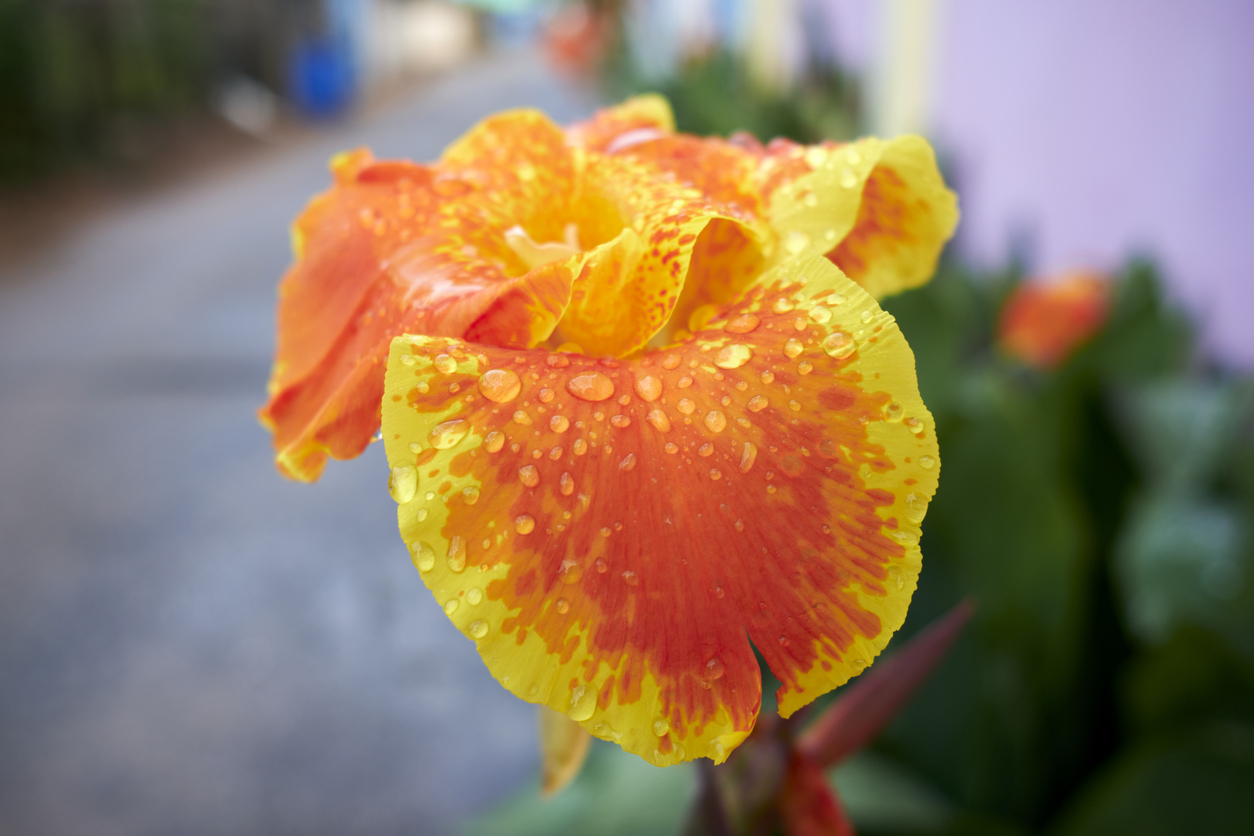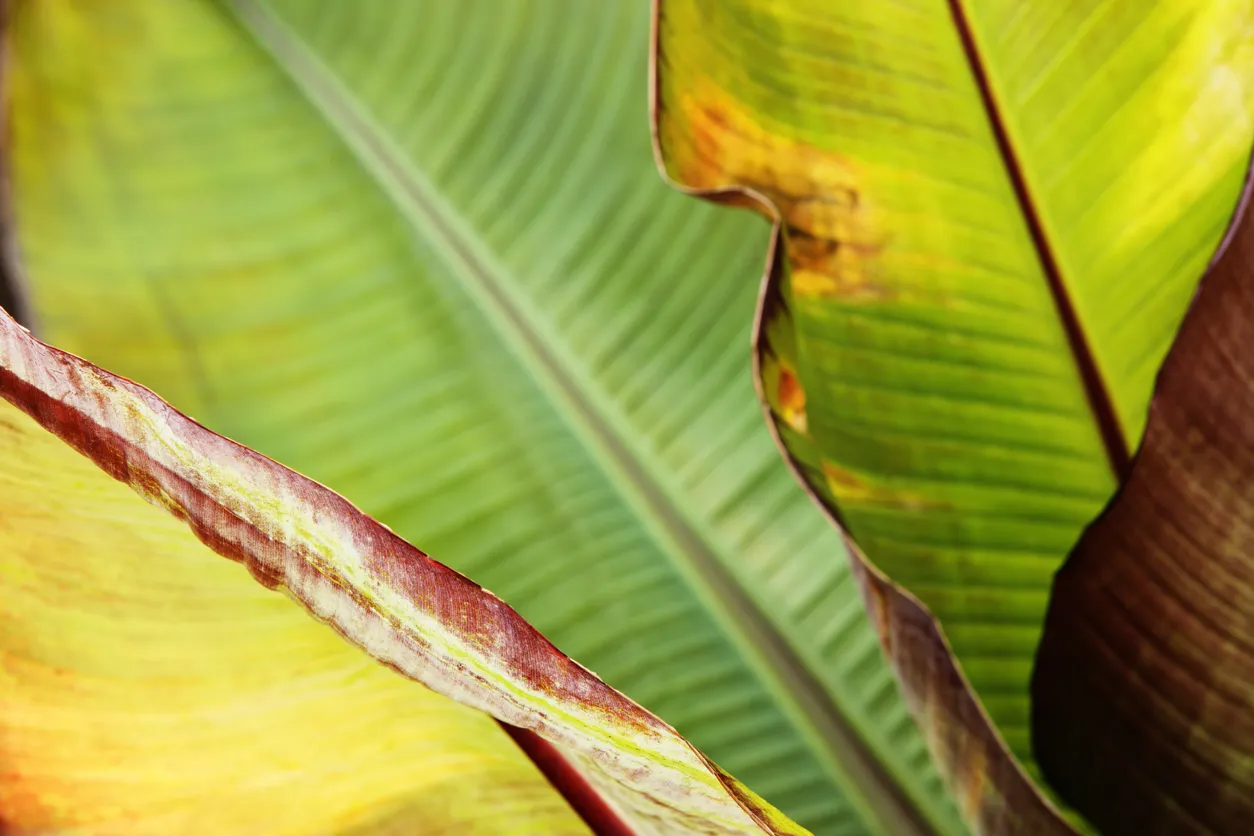

We may earn revenue from the products available on this page and participate in affiliate programs. Learn More ›
Definitely not the wallflower type, the canna lily plant grows big and bold. Brightly colored foliage often accompanies its brilliantly hued blooms, and a single canna flower typically can grow 4 to 8 inches long.
Fortunately, canna lily care isn’t difficult. When raised in Northern zones, however, these plants typically don’t flower until mid-to-late summer when grown outdoors. In warmer climates where they can be left in the ground over winter, cannas get an earlier start and may bloom all summer and into autumn.
Growing Canna Lilies at a Glance
Common Name: Canna lily
Scientific Name: Canna x generalis
Hardiness Zone: 7 to 11
Soil: Fertile, well-draining, pH 6.5
Light: Full sun
Water: Plentiful
Food: Balanced fertilizer
Propagation: Division or seed
Safety: Nontoxic

Canna Lily Characteristics
Canna lily hybrids (Canna x generalis) vary in height from 2 feet for some dwarf cultivars to 14 feet for the mammoth ‘Musifolia’. Cannas definitely make a statement with their paddle-like leaves that grow up to 1 foot across and 2 feet long. They also resemble plants like orchids and gladioli. Only marginally hardy in Zone 7, they should be heavily mulched over winter there.
Since they are related to bananas and gingers, most types of cannas are native to tropical sections of the Americas. Although somewhat drought-tolerant once they become established, cannas generally need plenty of water to maintain their size. Some can even grow at the edges of garden pools. However, others may rot under those conditions, so it’s best to choose water canna (Canna glauca) cultivars for water gardens or soil that retains water.
Recommended Canna Lily Varieties
The common garden canna (Canna x generalis) most likely came about as a cross between wild and water cannas. Some popular canna varieties include:
- Canna x generalis ‘Bengal Tiger’: This 4- to 6-foot-tall tiger can’t change its yellow stripes, which decorate green leaves. These striped leaves are accompanied by orange flowers.
- Canna glauca ‘Erebus’: Despite being named after a Greek god with a dark reputation, this water canna shines bright with coral pink flowers and gray leaves with a blue tint.
- Canna x generalis ‘Musifolia’: Usually grown for its huge size rather than its pale red blooms, this “banana canna” looms large at heights of 12 to 14 feet and has maroon-edged green leaves.
- Canna x generalis ‘Red Futurity’: This red canna lily is a dwarf type that grows up to 3 feet tall and features burgundy foliage.
- Canna indica ‘Tropicanna’: This popular “tropical canna” is a 4- to 6-foot-tall variety with orange flowers and foliage streaked with pink, purple, red, and green.
RELATED: 10 Perfectly Good Pond Plants You Should Be Buying at Your Local Nursery

Planting Canna Lilies
Opinions vary on the proper depth for planting canna bulbs (which are actually rhizomes), due to the fact that the diameters of those rhizomes vary. To err on the side of caution, place them deep enough that you can cover them with 3 to 6 inches of soil.
When is the best time to plant canna lilies?
Set out canna rhizomes in spring after the last frost and when the soil temperature has warmed to at least 60 degrees Fahrenheit. Alternatively, start them indoors by potting them in damp soil 4 to 6 weeks before the last frost and placing the pot on a sunny windowsill.
Where can canna lilies grow?
Choose a location in full sun but protected from wind, with fertile, well-draining soil that has a slightly acidic pH of about or just under 6.5. Although native cannas often grow in shade, they have smaller blooms than modern hybrids do, and ginormous hybrids need as much light as they can get.
How do you plant canna lilies?
Break up large clumps of rhizomes into sections, each of which has at least three to five eyes (red buds).
- Dig a planting hole 4 inches deep.
- Place a rhizome in the hole, with its eyes facing upward, and cover it with 2 inches of soil.
- Space dwarf cannas 1 foot apart and larger ones 1½ to 2 feet apart.
Can you grow canna lilies in containers?
When growing canna lily in pots, choose dwarf varieties, which can flower within 2 months after planting and aren’t likely to outgrow their containers. (Larger cannas often require 3 months from planting to bloom.) Place the dwarf rhizomes in 5-gallon pots (12 inches in diameter) that are filled with standard potting mix.
RELATED: Late Bloomers: 25 Summer Flowers to Keep Color in Your Garden
Watering Canna Lilies
As was previously mentioned, cannas require quite a bit of water once they have begun to grow. About 1 to 2 inches of rainwater per week provided either by Mother Nature or irrigation is recommended. You may also want to mulch them after the soil has heated up to help it retain its moisture. Cannas raised in containers may need to be watered twice a day during the peak of summer to provide them with adequate moisture.

Fertilizing Canna Lilies
One of the most important parts of canna plant care is feeding. Just before setting out your rhizomes, dig a balanced organic fertilizer such as 10-10-10 into the soil, adding about ¾ cup for every 10 square feet of ground at planting time. In mid-summer, feed the cannas again with ½ cup for every 10 square feet.
To sustain container cannas, mix ¼ cup of the fertilizer with the potting soil for every 5-gallon pot before you plant the rhizomes. In midsummer, add an extra 2 tablespoons of fertilizer to the surface of the soil in each pot and scratch it in.
Pruning Canna Lilies
Cannas don’t require much pruning except deadheading. Once the flowers on a stalk have bloomed and faded, cut the stalk back all the way to the base of the plant to encourage a new stalk to sprout. After frost kills the foliage in autumn, prune all of the stalks back to 4 to 6 inches above the ground before you either mulch the rhizomes or dig them up to move them indoors for the winter.
Propagating Canna Lilies
Most canna propagation is by division, a process described under “How do you plant canna lilies?” above. If you want to grow canna from seed instead, keep in mind that hybrids won’t come true that way.
Drop all of the seeds into a cup and pour water which has been heated to almost boiling over them. Then soak the seeds for 24 hours before you sow them in a damp and sterile seed starting mix. Barely cover them with the mix and keep them in a 70-degree Fahrenheit location until they sprout in 1 to 2 weeks.
RELATED: 25 Easy-Care Plants That Survive With or Without You
Safety Considerations
The canna plant is not toxic to either people or animals. In fact, according to North Carolina State Extension, the C. edulis or C. indica species also is known as arrowroot. Its edible tubers, which produce a starch known as achira, are sometimes grown as a food crop.
However, contact with canna lily foliage reportedly can cause rashes or hives in some people, though the reason for that is unclear. Therefore, it’s probably a good idea for gardeners with sensitive skin or other plant allergies to wear gloves while handling the plant.

Potential Pests and Diseases
Canna lily care includes watching for potential pests and pathogens. In the South, cannas suffer from leafroller caterpillars. Watch for webbing that seems to be preventing leaves from unfurling. If you see it, remove any caterpillars inside by hand, or snip off the upper part of the leaf and spray a caterpillar control such as this highly rated organic Bacillus thuringiensis (Bt) available at Amazon into what remains.
Canna lilies also frequently carry viruses, which can cause foliage streaks or mottling, stunted growth, deformed flowers, and other symptoms. Those symptoms can be hard to detect on plants that have naturally striped foliage and asymmetrical blooms, unfortunately. Since there is no cure, you should completely and properly dispose of any affected plants.
Preparing Canna Lilies for Winter
Canna lily winter care differs depending on your hardiness zone. If you live in Zones 7 through 11, you can leave cannas in the ground over winter, after mulching them with 8 to 12 inches of fall leaves after pruning the plants.
Gardeners north of Zone 7 should dig up canna lily rhizomes after cutting them back, dry them, and store them over winter in a box of slightly damp peat moss or vermiculite. Keep the box in a chilly location where temperatures typically remain between 40 and 50 degrees Fahrenheit but don’t drop below freezing, such as in an unheated garage.
Looking for more large-flowered plants? Check out our guides on growing dahlia, hibiscus, and zinnia.
